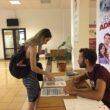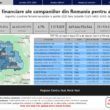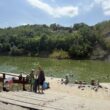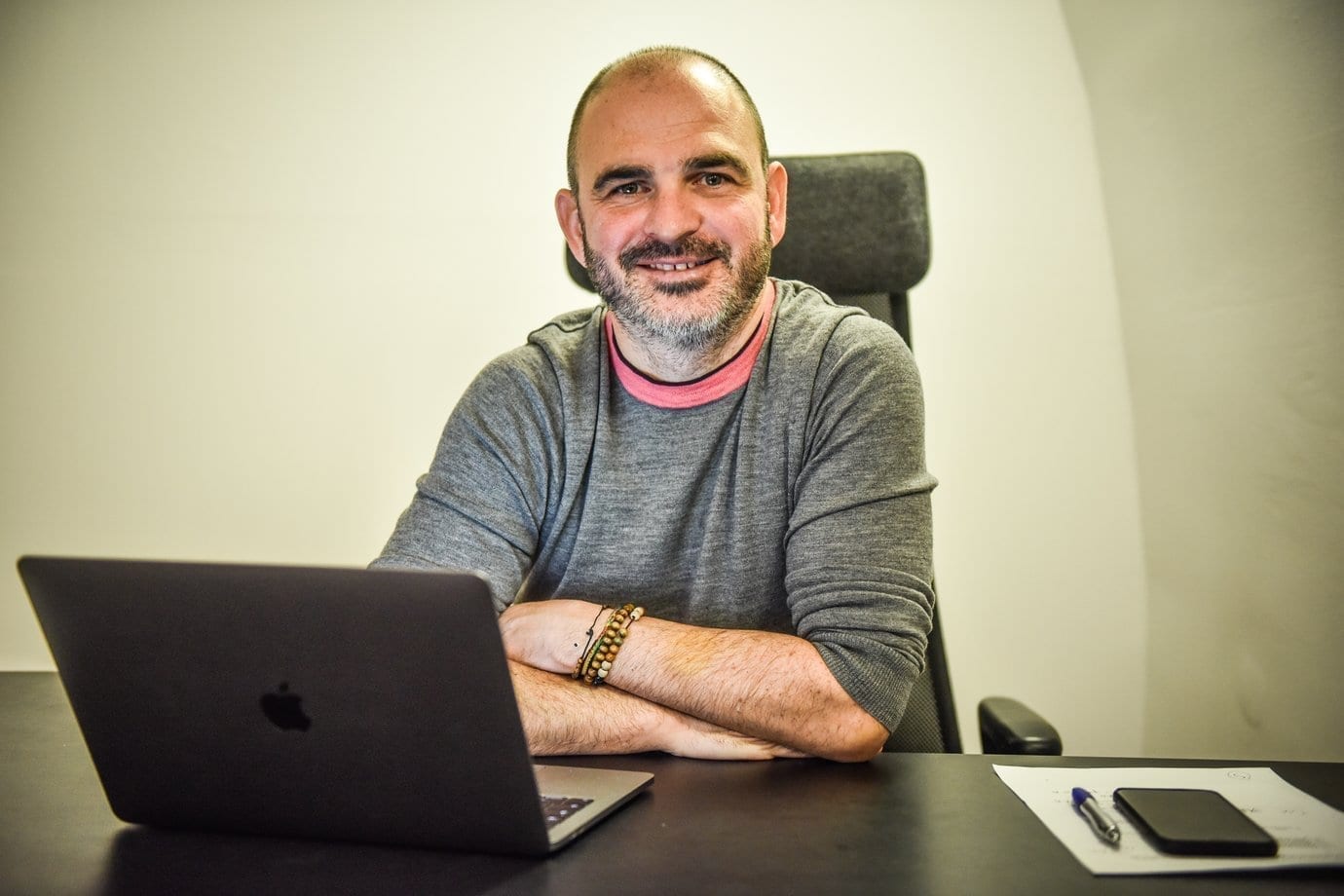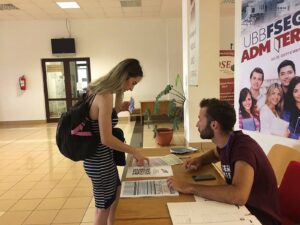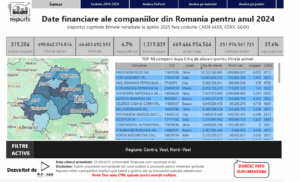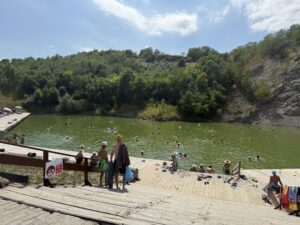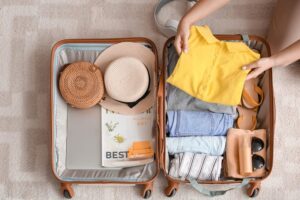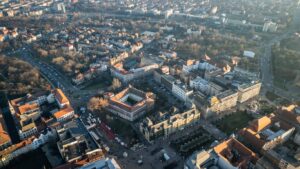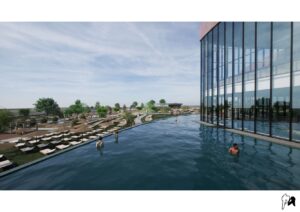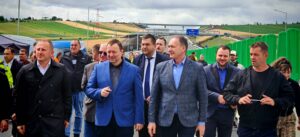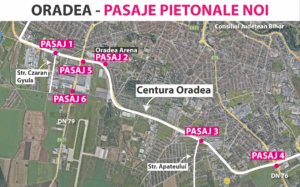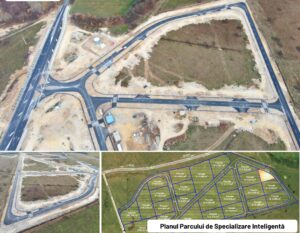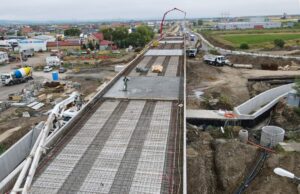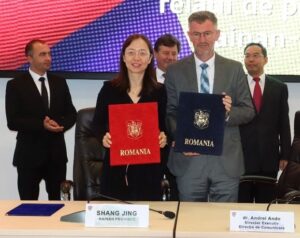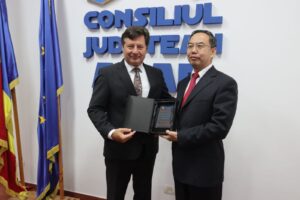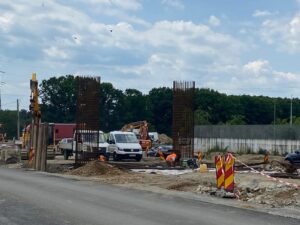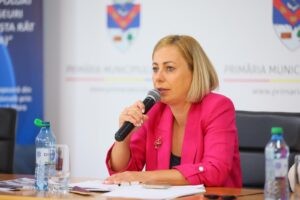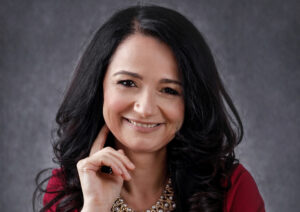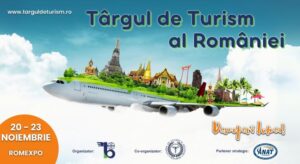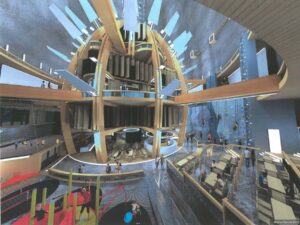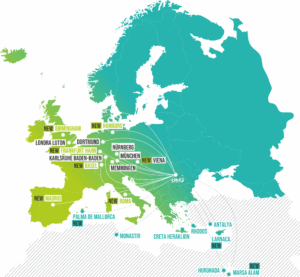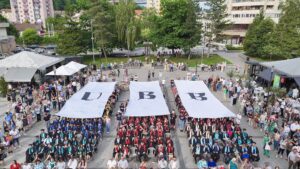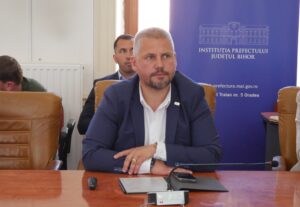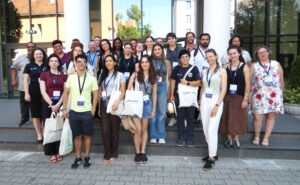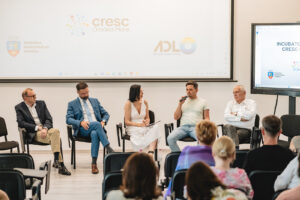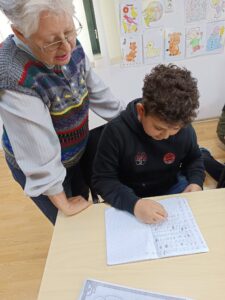Alin Uhlmann-Ușeriu, I propose to start this conversation about Via Transilvanica slightly indirectly. You have been walking all your life: as a child, as a volunteer, on the country’s mountains, with friends wandering about in the country, you have walked the Camino. What is the meaning of walking and what does it do to a person?
Via Transilvanica is about a path and lots of walking. We cannot avoid the question: What is the meaning of walking on foot? What does it have to do with finding oneself? I think it is a necessity, an innate human gesture. We were made to walk. Not to run, not to climb summits, but to simply walk.
I understood this and I had the time to process these thoughts when I walked alone on the Camino, for 50 days. The least 8 km, the most 48 km in one day. You cannot avoid not asking yourself questions. Even now I ask them, after 4 years: what was I doing there, what did the road teach me, what is the connection between walking and myself, as a human being?
My personal history is, actually, a little history of walking. It is divided into stages: from the end of a walk to the beginning of another. My parents sent me after the cows when I was a child, not far away from this place where we are, in Tășuleasa. ‘Go and bring an onion from your grandma, take a matchbox to your other grandmother’ passing through the woods so frightening for a child that one would make the sign of the cross with the tongue, because fears do not show themselves, not even toward yourself, not to melt your heart.
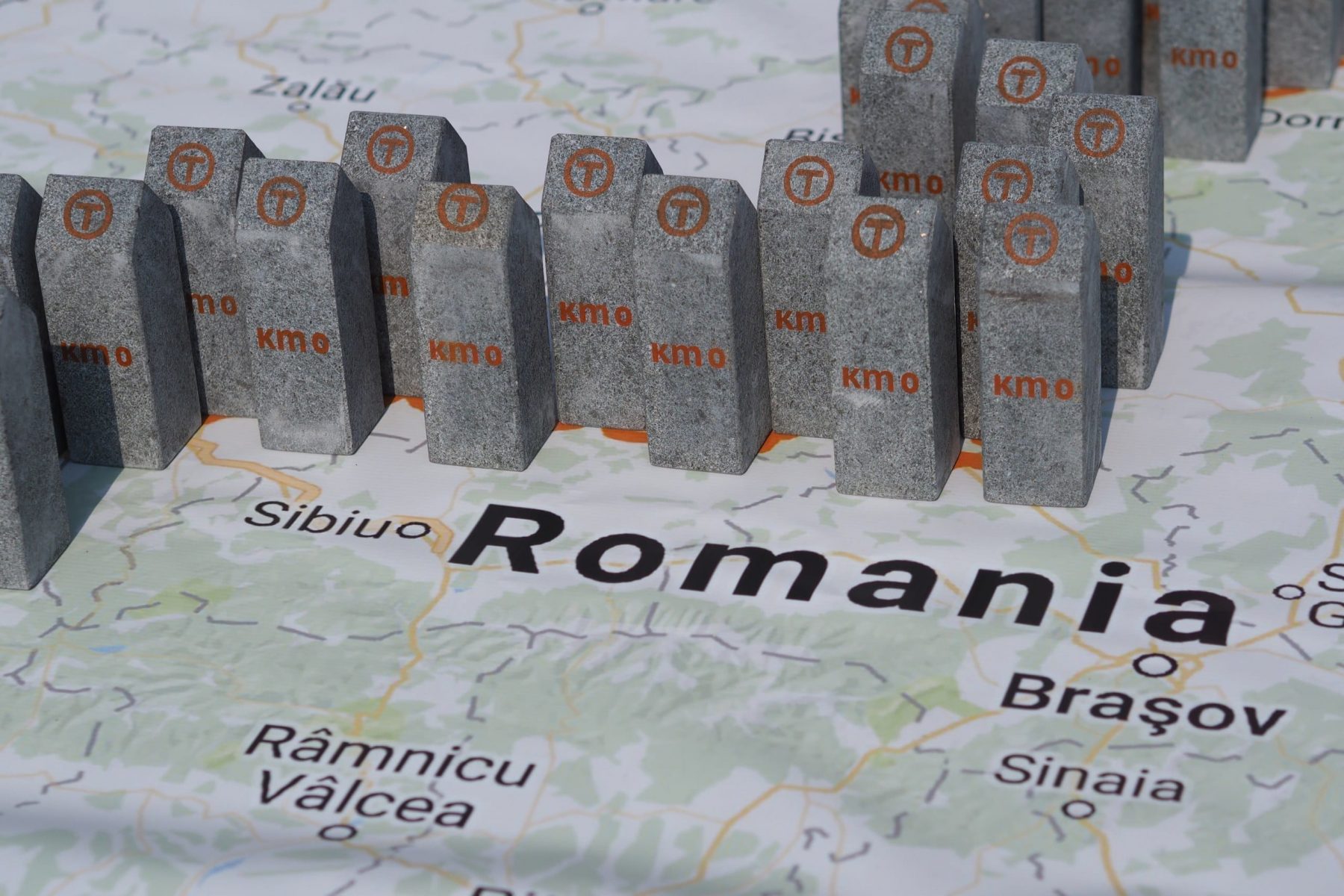
You were a mountain guide, mountain rescuer…
When I was a teenager, I went through an extreme phase. I wanted to go on all our mountains, then to climb all peaks over 2,000 m, but this was more of a competition, an athletic activity. It was about performance. And this has nothing to do with normal walking, steady, connecting point A from a point B and in which you learn something about your companions and especially about yourself.
This is what Via Transilvanica is: the lesson of a necessary therapy, something against the stream. Especially now, when walking tends to go out of fashion. We want air conditioning and fast transport, whether we talk about the metro, tramway or the minibus taking the children to school. It takes them from the front of their house, and it brings them back there. I remember, I would walk for 3 km to school, on foot. People walked to work, sometimes even in the industrial area. Now people have become very lazy. This is a problem.
I walk daily somewhere between 2-5 km, which proves that I exist, that I am alive. I have three friends with whom I go on foot, on mountains and hills around 200 km per year. Or I walk with the children who come to our campus, I take them at least once to the Tășuleasa Peak.
This simple idea of placing a step in front of the other has something magical, it brings a unique clarity. With Tibi for instance, I am not able to link ideas drinking coffee, instead we can hold long conversation sessions walking and running. Keeping pace with him is not exactly easy, luckily, he is patient with me and he adapts himself. We think clearly in nature and in motion.

You have, it seems, a history of attracting people toward you not only in the association’s projects, but effectively, getting them on the road.
Over time, you are right, I have walked not only on my own, but I have taken people with me. And as a mountain guide and association president involved in various projects, like the Mountain walking school. Only in this story I have helped directly or indirectly over 1,000 grown people discover nature, to move on the mountains and maybe even like it.
And Via Transilvanica is somehow the fulfilment of an obsession. I consider being the president of an organization which conceived such an endeavour a gift from God. You have no idea how happy I am that alongside others, I have become the initiator of this project that puts people on the trail. It gives them impetus, somehow, to discover themselves, discovering a country on the go. Remembering El Camino, the most classic pilgrimage path. Imagine that 2,7 million people arrived at Santiago de Compostela in 2017 to receive a certificate that they have covered the entire distance, whether they have come from 4,000 km away, or they have travelled 120 km on a network of roads spread throughout Europe. It is about an initiation. When you are born, you enter in the life’s labyrinth, you have to go through several paths. Practically, you become what your own steps had made of you.
How did Via Transilvanica happen? The manner in which the ideas coagulate and how did it happen for this project, one of the many projects by Tășuleasa Social that now catch speed and seems to garner enthusiasm more than others. Why is it?
Each of our projects it is somehow created to garner enthusiasm, be it planting, collecting plastic, offering gifts, organizing schools for mountain walking or for young volunteers. What is shocking about Via Transilvanica is that we have managed, in a colossally short time, to gather an enormous sum of money. This never happened to us before. We now have about 400 thousand Euros destined for the next 400 km of trails. Indeed, I think that this project has strung not one, but several sensitive chords. It is a surprise.
Let us sketch the context. In the past 30 years in Romania, the majority of successful projects in the NGO area were created somehow on the negative, implying the word ‘humanity:’ poor people, living in hardship, children with cancer, hospitals, etc. There are enormous social projects, that have coagulated knowledge, people have responded, and millions of euro have been collected from all over the world. And it is admirable.
But it is unusual to have the sudden start of something positive, of national scope, as a public invitation to become part of something that is built on the go. Our society cannot live in the negative all the time, I think. Via Transilvanica charms people because it has a positive aura, it is no longer about poor people, but about all of us, it is a luminous, non-aggressive story.
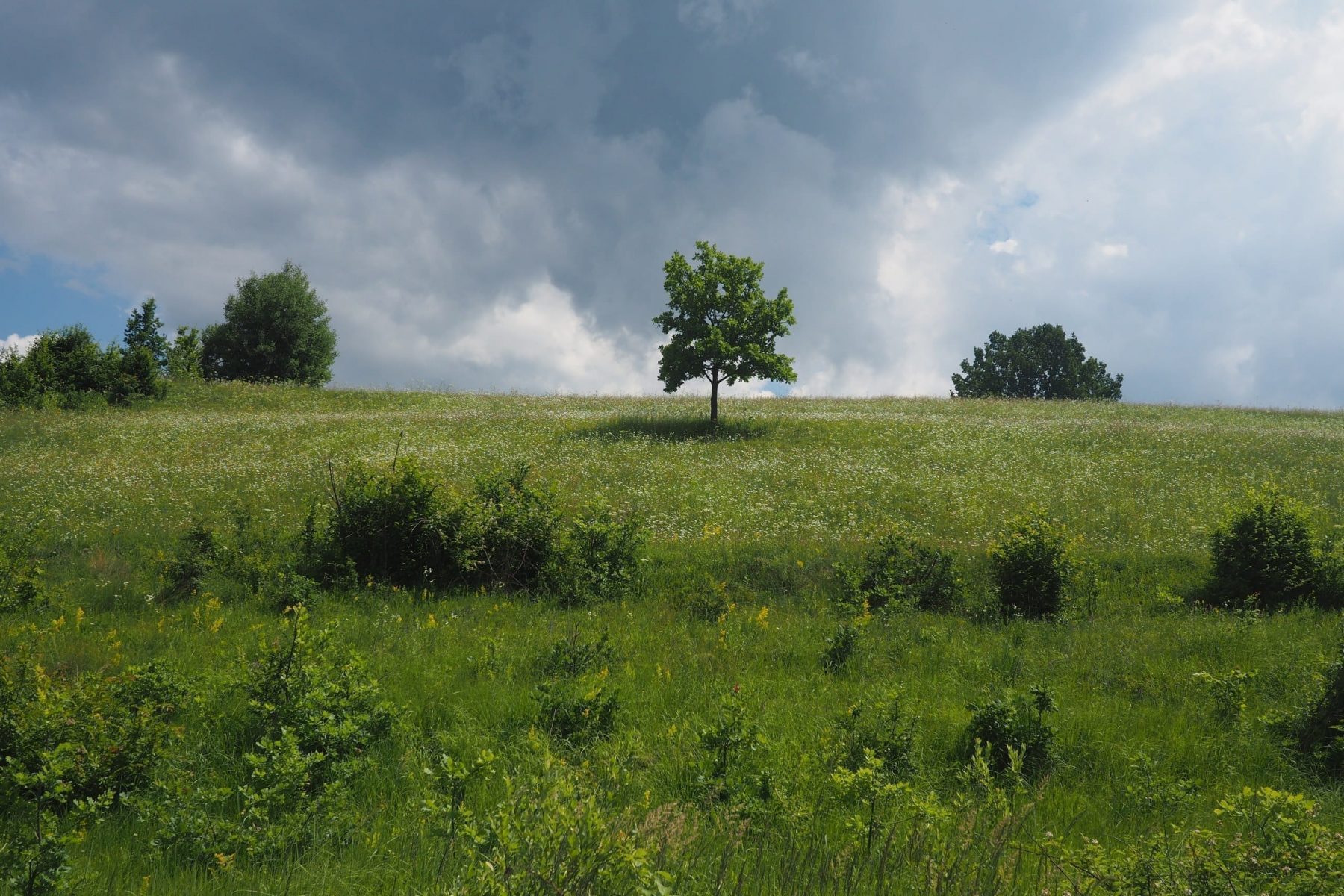
Can the enthusiasm for Via Transilvanica also be connected to the fact that we seem to be a country frozen in an eternal project? We are a state that is incapable of finishing large infrastructure projects, such as decent roads. Everything is always blocked in auctions, expropriations and feasibility studies.
This is a more complicated discussion. The Romanian state is the answer to who we are, in reality. It is like you go for medical tests and you end up with bad results because you have been living a gnarly life. The situation with the Romanian state and its politicians is sort of like this. They represent the ‘tests’ for a certain health condition, and we are the nation’s health condition. And the nation is as it is, imperfect, as much as we are content with this thing. We have constantly denied out values, and we have murdered those who have achieved the Union ourselves, in our prisons, not those of the Turks.
Let’s tackle another angle. I have lived in Germany for 12 years. And I always thought about how I could translate to my friends what my country is about if they wanted to visit it. Well, every time new themes arose: let’s go to Bran, let’s go to the Transfăgărășan, let’s go to Moldova, to the monasteries. It always ended up a road trip. But there was no cement, no connection, something that had a story.
Let’s not forget that Transylvania is Romania’s most serious country brand. The Danube Delta then follows. We insist on selling The Carpathian Garden or Mother Mary’s Garden as country brand, which proves our inability to tell a credible story. At tourism fairs we promote bears, virgin forests from which we clear out, we promote wilderness until people will begin to believe that the country is inhabited by some savages.
One day I could tell my German friends: ‘Look, Transylvania now has its own path, a long-distance trail, which will reveal a people’s history and story.’ A Romanian emigrant to America would be able to explain to curious fellow citizens: ‘Yes, there is a Pacific Trail here, but we have Via Transilvanica.’
Doesn’t it seem simple? This simplicity makes people identify with the project, to donate, to dream of walking the path. Next thing we knew and look, we already have 140 km that can be explored from tomorrow on. You only must put your hiking boots on and to set off.
We are talking about a touristic path or an adherence to an emotional story here?
It is not tourism; it is something more nuanced. The story starts from us, as an organization. It is connected to our coming of age. Just last year we reached legal age. And Via Transilvanica was born from here, from ripening in our minds, from a continuous struggle with ourselves for 18 years. I think that if we had 1 million euros 5 years ago, I don’t think we would have been able to build anything.
I don’t think we would have had the courage to propose a project that had to be assumed by an entire country. That empty saying about us Romanians being the most hospitable on the planet can now be filled with sense, tested. We will prove that we are hospitable only if we care for this trail km by km, community by community, that is about 400, let us clearly understand each other. Can we as a society assume this story or will we destroy it and eliminate it as a foreign object?
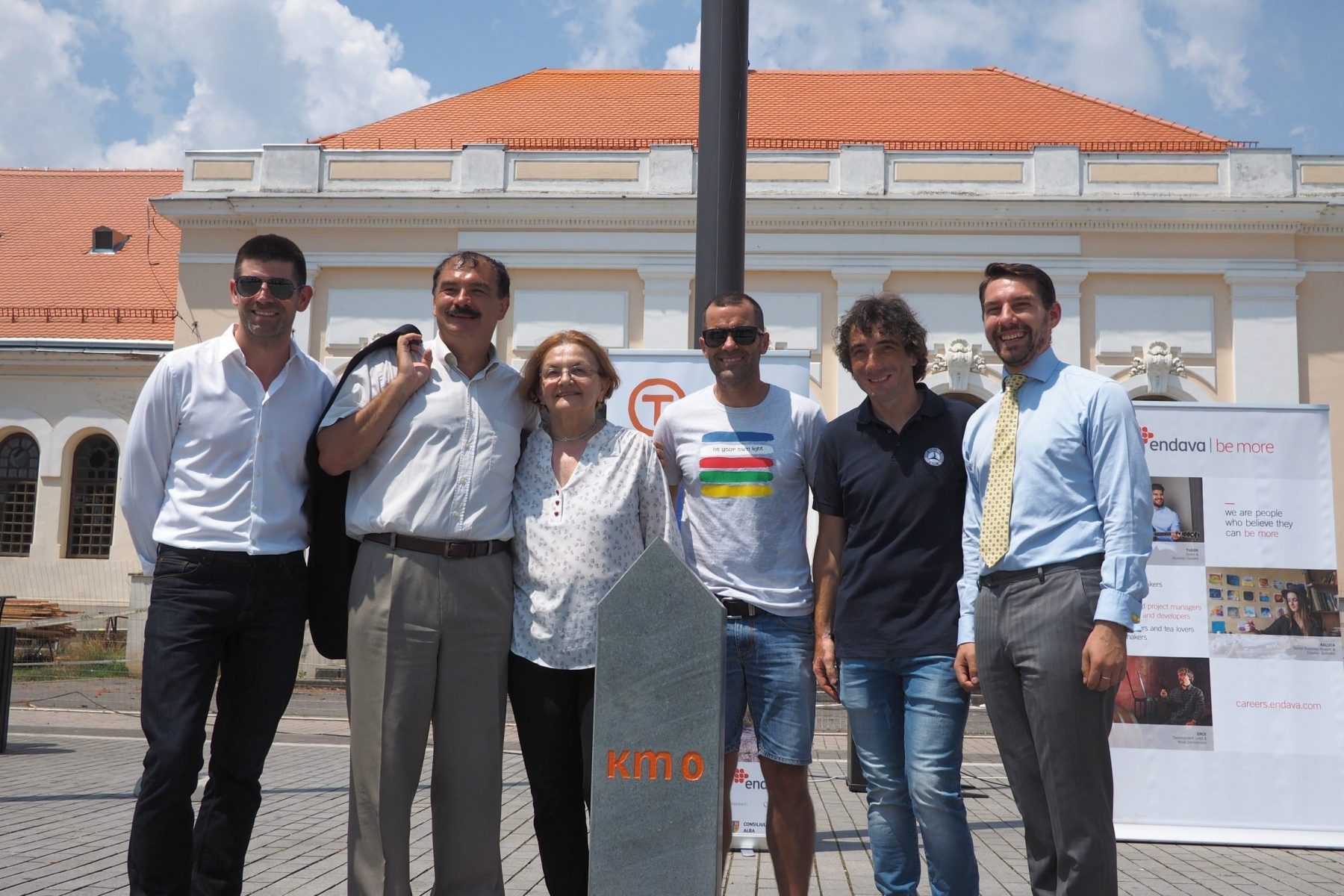
Do you believe that simple people will understand the benefits of such a trail near their households? Or, as some people always have something to hide, will they sabotage the project? We already have some vandalism cases on the many trail kilometers.
We don’t know, we’ll find out. This risk exists. But if you are fearful from the start, you won’t do anything. If you imagine Swiss tourists being eaten by Romanian sheepfold dogs, you become paralyzed. If you read mean comments, you become bitter. There are plenty of problems, but you have to start from somewhere.
One of my most secret joys is that Via Transilvanica passes through obscure villages, which do not exist on any map of so-called ‘touristic objectives.’ They are small pieces of heaven, that have neither salt baths, nor caves, nor waterfalls. Suddenly, something happens in their world, a trail passes, and people will walk on that trail. Well, this thing is waiting for the community’s answer, and until now the reactions have been encouraging.
Most non-governmental organizations, with us in the lead, have been over time committing an enormous mistake. We went to the communities, and we told them: ‘We will teach you, that is you are rather uneducated, we will give you something, that is you are rather poor, we will show you how it is done…’ This sort of thing is, from the get-go, seen with great distrust.
Via Transilvanica teaches us first a great lesson, the lesson of humility.
With our guard down, with our pride low we have to go in absolutely every village of the 400 and tell them:
We have not come here to teach you lessons, we have come to offer you a path, a way. You have to stay as you are, your oldest houses have to be minimally restored, to be clean and habitable, don’t build stainless steel villas and space ships.

An old country house will be cherished by a traveler who will sleep there and who will buy cherries from the old cherry tree in the backyard. You, residents of this village must be partners in this project. You already know everything. You know how to make an omelet and how to make polenta, you become the main actors.
And the communities, at least apparently, were enthusiastic. The adherence is not only for the over-1,000 donors who, in average, have donated around 200 lei or for our important sponsors, but it is precisely for the people living in forgotten villages. Now, this thing gives the story its organic aura. And as for me, it gives me trust.
How does Via Transilvanica link to the other Via Maria Theresia trail, on which you worked on?
This border trail going through the Călimani Mountains was known, but no matter how much I tried to propose its rehabilitation, nothing gelled. Wilderness, splendor, history, national heritage, a trail, a story and nothing. It wasn’t until the arrival of our friend, professor Mircea Miclea, who connected with my brother, Tibi Ușeriu’s obsession to organize an athletic competition. And this was the birth of the story which in its turn birthed the larger story, Via Transilvanica.
We worked really hard to mark the Via Maria Theresia trail. In 2018 we celebrated the competition 5th anniversary, a successful one, exemplarily organized, which gathered over the years more than 10,000 people. We invested a lot in safety, and this generated trust. We had no serious accident in 5 years, which proves that we have done our homework well.
Plus the vibration brought by many volunteers, who carried melons to the top of the mountain. For years we have invested enormously to create this culture of volunteering. We could live by ‘lending volunteers’ to other organizations, such as those led by Dragoș Bucurenci or Ivan Patzaichin, whom we helped.
Initially the two trails cohabitated, but we then realized it is better to separate them, because they have different identities and lives. But anybody who feels like deviating from the trail, can venture to the Via Maria Theresia, only a few km away.
Does that mean that Via Transilvanica may have all sorts of collateral smaller paths attached?
Imagine the back of a fish. Its spine is the Via Transilvanica, and its little bones are the possible trails, maybe tens or even hundreds. I estimate that, in a reasonable span of time, this trail will be crossed by around 200,000 individuals a year. Maybe not the entire 1,000 km, but on various sectors. The signs are already really positive for the 140 km. Many have completed the track; others are preparing to do so.
The trail only goes through Brașov county on a small distance, around 10 km. But the county council president alongside the business environment came up with an idea. Creating an offshoot to the Black Church in the city’s center, with signs, milestones and all. There are other such organically-born ideas coming from Cluj and Sibiu as well.
Well, I see an enormous chance here for us to become visible. Because if you look on the worldwide tourism map, there are more things to see in Mongolia or Sahara than in our country. It seems the desert is here, not a 2,000-year-old culture. On the European Union’s map we seem like an uninhabited country. How is that possible? I noticed this at the Bistrița-Năsăud trail’s certification by the Ministry of Tourism.
Believe it or not, apart from this stage of Via Transilvanica, there is no other certified hiking trail in the country. The only ones are those on the mountains, with a very old history. But nothing that is on foothill or thematic, such as the wine, road, or caves road, nothing.

Please cut an imaginary road section and tell us what would marking a km of this trail would entail. Logistically speaking, what energies, what costs would it imply?
First, we talk about directly impacting around 2 million people. The trail crosses 10 counties in the whole country, it is not a joke. A kilometer costs, loosely, 1,000 euros, this is an organizational calculation. An andesite milestone, which serves as a witness and sentinel, costs in itself around half of this sum. Let’s not forget, it is personalized and sculpted. Those who donate sometimes want certain motifs to be engraved in the stone, whether we talk about grandma, about Iuliu Maniu or Cardinal Iuliu Hossu.
Some have asked us: Why didn’t you just paint trail signs and then, if it will be validated by hikers, only then put some milestones? No, we wanted to make everything progressively, learning on the go. We could have easily rushed everything by painting the sign with Via Transilvanica on the trees and on all the fences, but we didn’t want that.
The trail’s union needed something monumental, a solid milestone, weighing 230 kg, on a cement foundation. We thus assumed these heavy milestones, made of andesite, which would probably cost 5 times more if a foreign company would have to turn them on all sides.
Luckily, we have here, in the campus, high-quality logistics, we have employees. Sculptors from all over the country come to us as well, we organize a camp, we offer accommodation and meals. The rock itself is strong, durable, comes from the Rodna Mountains, it is not some bounders brought from China, it is sandblasted here in our yard. It is beautiful to imagine an exhibition stretching from the Danube to Putna.
Then follows the specific signaling, the road signs. You always have to have the next sign in your visual range at about 50 meters, not to get lost. We hope that people from everywhere and of all ages will come here. They will cover the trail on foot, on a bike, riding even.
And what will you do to ensure a minimum safety?
You have a number of unavoidable maintenance, communication costs. But there won’t be any large red panic button for you to press and we’ll teleport there to salvage the situation. This is why we created the guide, which is a printable PDF file. There were 5 girls who walked the trail step by step and then worked another month to write up the guide.
This guide will be a sort of work in progress, we will constantly come back over it with new information, details and it will ultimately cover the entire trail. As the trail will organically grow, the guide will be diversified in several languages, I am sure of that. The marking itself is on limited costs right now, we are in our own county. But in Sibiu the price could go slightly higher, we are talking about transporting a ton of stone.
You divided the trail into 7 regions with specific regions: Cerna, Terra Daco Romana, Mureș Valley, Terra Saxonia, Terra Siculorum, Călimani and Bukovina. Why?
Because it is important to discover the ethnic and cultural variety embedded into our own country’s inner fiber. We had to consider the natural beauties, the historical regions, the ethnic diversity, because this is Transylvania in reality. People. They are the land’s salt. This project starts and ends with them. Now, they are not all the same, we call them Romanians, but they are very diverse.
Terra Siculorum contains a very interesting and capable people (the Szeklers), with whom we have had our historical matches, in the same way as they Hungarians may have had. But they are an enormously important component for Transylvania. How can we ignore this fact?
Or Terra Saxonia. Today it is perhaps one of the most interesting open-air museums in the world. We are talking about an impressive culture, a thousand years old. We are talking about an almost mythical land, guarded by fortified churches, many of them renovated, which has a unique charm.
This trail will be a great open lesson, with a minimum fingerprint on the environment, with hardly any negative connotations. It can only do good, it passes through public roads, the paths exist, we do not build, we do not cut, we have a maximum respect for the places which we cross.
Who are the actors involved in this dance? Local authorities, sponsors, volunteers, donors, ambassadors? Let’s talk a bit about each, at a time.
Let’s be honest. In 18 years Tășuleasa Social had no declared political affinities, it never used public money. Our way of manifesting and protesting has been centered on deeds. We went where there have been abusive deforestations to plant, we fought with everybody, then we reconciled with everybody, because we were forced to work together.
We started with Bistrița, so we met with mister prefect and mister president of the county council. This is how it works in any country; you must work with those put there to administer it. We gradually understood that you cannot have a belligerent attitude, because that way you achieve nothing. There is no purpose of planting, if you have nobody to foster the future forest, there is no purpose of working with children from a community where parents are hostile towards you.
Here you don’t only need to obtain approvals to put some signs, but also a promise that local authorities will keep watch, will continue to help, will fix a footbridge, will report a missing sign and other things.
Until now we have met with members of Social Democrat Party, with liberals and with members of Democratic Union of the Hungarians in Romania. Beyond political colors, we have met with a number of people and this is what makes the difference. We clearly have no political stake, yet we found ourselves having to work together with a locality’s administrators. The great surprise was that they reacted very positively, because the project appeals to the locals. The force comes from bottom to top, very democratically, this is a nation’s secret, not the directives assigned from the area of power.
I admit I detest mister Radu Moldovan’s political options. But I cannot avoid admitting that I have been working exceptionally with him, that he was a genuine partner and together we created a model that could be replicated by the other counties as well. Now we are dealing with another county leader – mister Flutur. I am looking forward; I hope it will be alright.

Sponsors? Seen and unseen?
Exactly one year ago we made optimistic calculations and we thought we would be able to barely gather money for about 20 km. Next year another 10 km, and so on for about 10 years until we become old and we retire. We would abandon the story and like 30 years from now, somebody will look at the andesite stones and say: ‘What a cool idea these ancestors had, maybe it is worth continuing it.’
Well, last year, until September 29th we scratched off 140 km with the mobilization of several hundreds of locals, with mayors and cadaster, council leaders etc. Our traditional partners entered the stage, those with whom we had a relation for many years: the strategic partnership Raiffeisen Bank, Coca Cola, but we were also joined by local companies, like those of Lactate Monor. Or new partners, like Egger.
But we were swept of our feet by the donors’ enthusiasm. Any donation means the beginning of a partnership. A lot of them are from the diaspora, with impressive stories. Somebody who donated a significant sum wrote to us: ‘Behold one of the projects that could make me come back to Romania.’ We will place somewhere on the trail a special, spectacular, monument, which will be a sort of homage to all of our sponsors and donors.
This is the force of society, the best form of implication and protest: deeds, participation, going forward. And this in a country that has 0.2 recurring donors from the population total, that is next to nothing. We also have company volunteering, such as Endava or Branzas Design. So, the project, seemingly destined for the next Centenary, could approach its half with a little bit of luck, in a record time.
The way things are, when would Via Transilvanica be finished and marked?
I don’t know, reasonably-optimistically maybe in 3-4 years, if no calamity, no blockage intercedes. We were bombarded with many promises; we don’t know if they will materialize. We don’t only sell kilometers; we also sell emotion and we guarantee with the already proven trust. We depend on donors, on authorities. We are still stubborn not to take public money, but we ask the city halls to save some money for upkeeping, for traffic lights, for pedestrian crossings, fixing footbridges, etc., unexpected vandalism, because there the money will return indirectly, from the travelers’ pockets. The marking belongs to us, so does the Via Transilvanica brand and they are all morally in our possession and indirectly belong to the sponsors and donors. We give a finished, turnkey project. The communities must learn on the go what they have to do with it, to adapt. This happened on the Camino as well. Once it had daylight robberies. This was the reason for the birth of the Knights Hospitaller order, those who protect the travelers.
We will give one example. At the campus gate we created a special refuge spot for travelers. We will provide running water and put a sink there. Yesterday we had 8 young people of which 3 were riding bikes. If necessary, we can also offer accommodation in return for a donation.
Ambassadors?
I can only start with my brother Tibi, a Tășuleasa Social product, who identified himself with this mission as far as personal sacrifice, as not long ago he almost froze at Yukon Ultra. We also have many distinguished people: Andreea Esca, Mircea Miclea, Marcel Iureș, Dragoș Bucurenci, Prince Nicholas, Mani Gutău and others.
Ambassadors not only stake their own prestige, but they assist you on the go, because you can always make mistakes and go astray. They are influencers who help us gather funds, these people are very important to us.
These ambassadors also assume risks alongside us. What if we hit the fence? What if nobody will want to walk this trail? What if it will get destroyed? It’s not exactly a picnic to spread tons of andesite throughout the country. It is a matter of scale, that needs humongous energies. The risks match that.
‘Cale bună (Good Trail)’ as equivalent for ‘Buen Camino?’ Do you think this greeting will catch on?
This is Ana Szekely’s hand, our programs directors. She came up with the idea. She was also the one who came with the Tășu abbreviation and many of the things we are naturally using. And this slogan is exactly like the entire project. It depends on us if we will use it, if it will be validated in time or not.
Informing and communication are two important components, they have an educational role. We wrote a letter for each of the inhabitants of all the communities. They are about 4,600 families in the 10 Bistrița-Năsăud townships.
We used children-messengers who gladly took the letters and they were well received. There we explained to them what Via Transilvanica was, we suggested what they should and shouldn’t do, we told them how important their involvement was. The last sentence was: ‘And we ask you kindly to greet the visitors with Cale bună (Good trail).’ From there on we will see, our duty is to try, to spread the seed. And not to stop hoping.
Voicu BOJAN
Photos by Voicu Bojan & Mihai Țuțu
(From the special edition of TB 86 – „ENJOY TRANSYLVANIA!” – 14 May – 10 June 2019)
